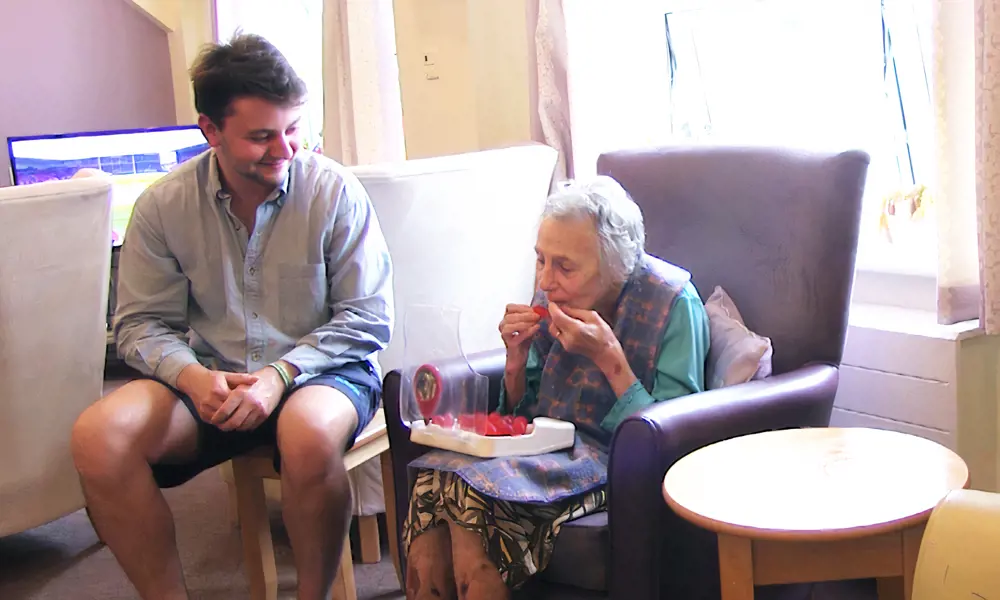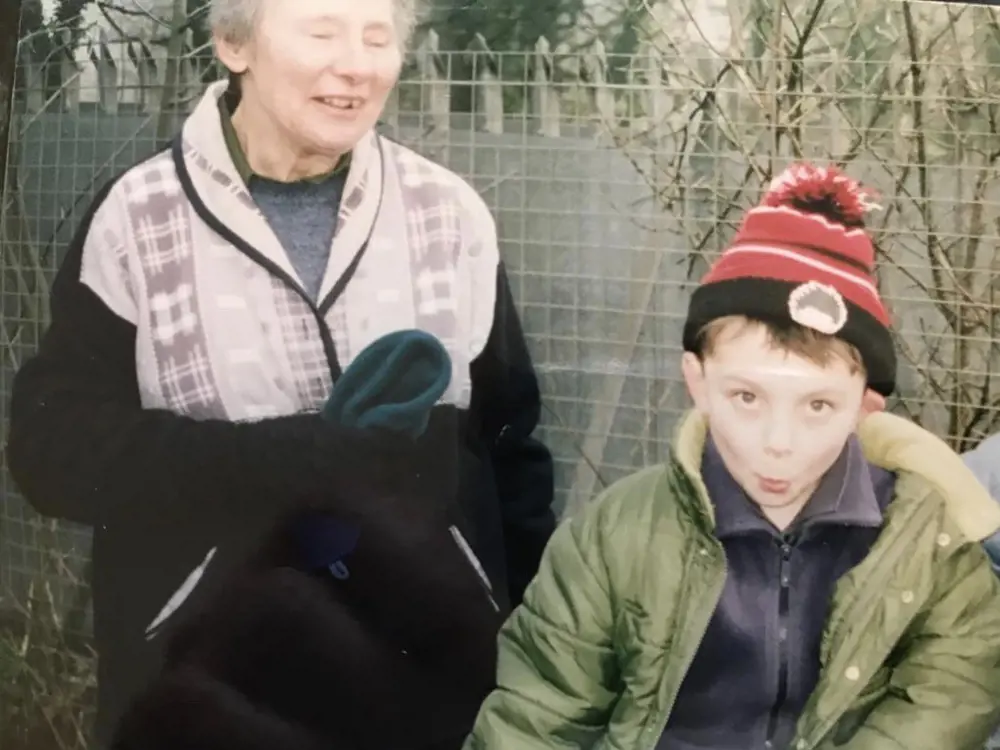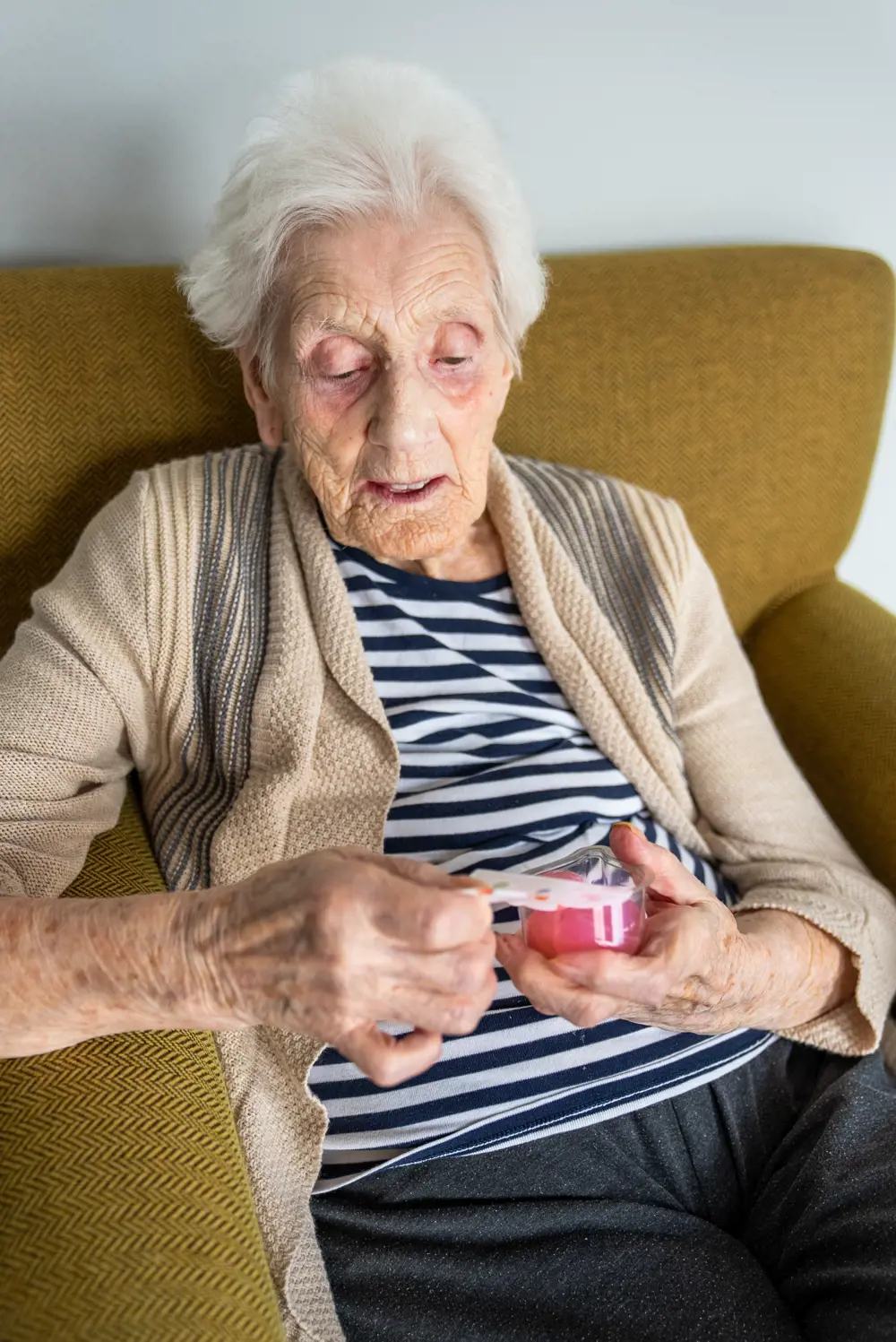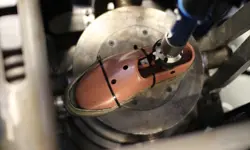
The water sweets helping people with dementia stay hydrated

Lewis in his school days with his grandma, Pat © Lewis Hornby
Hydration is a real problem for people with dementia, who may not realise or be able to easily communicate that they’re thirsty. According to the Alzheimer's Society, the sensation of thirst can actually change in older people, which means they might not feel thirsty if they’re becoming dehydrated.
Design engineer Lewis Hornby first became aware of this issue when his grandma Pat was admitted to hospital while he was an undergraduate studying engineering at the University of Bristol. “She went downhill very fast, was hospitalised, and [we] didn’t really know why,” says Lewis. “Then [after] 24 hours on IV fluids, she was absolutely fine and went on to have a good quality of life for years after.”
In 2018, Lewis was studying a master's in innovation design engineering at the Royal College of Art (RCA) and Imperial College London. He had several successful group projects underway, including one focused on advertising billboards that would reduce air pollution in cities. However, he decided that for his solo project he would head to Yorkshire and spend a month learning about the needs of care home residents. “I just thought it was a good excuse to go and spend a bit more time with my grandma, and see if I could help,” he says.

Lewis and co-founder Claudia testing Jelly Drops © Jelly Drops
Developing a sweet prototype
While there, he noticed that, among his grandma and other residents, he would become very popular if he brought in sweets. “I'd go to the care home most of the time and everyone would ignore me, which is fair,” he says. “But if I had some chocolates, then everyone’s your best friend, taking a handful and having a quick chat. I thought if I could make a hydration version of a sweet then people would engage with it readily, enthusiastically, independently.”
He developed a prototype in his kitchen and later applied for the James Dyson Award. To his surprise, the video he made for it went viral after someone posted it on Facebook. He describes how he was away on holiday and the group chat from his course started to go wild: “'oh, you're on the front page of Reddit!' And I was like, what's Reddit?” It made the Evening Standard and within a few weeks had reached 100 million views.
“I'd go to the care home most of the time and everyone would ignore me, which is fair,” he says. “But if I had some chocolates, then everyone’s your best friend, taking a handful and having a quick chat. I thought if I could make a hydration version of a sweet then people would engage with it readily, enthusiastically, independently.”
At this point, things had been going well with the air pollution removal startup, which had garnered patent support from the RCA and won several awards. But the team decided the traction behind his idea was enough to pivot to focus on hydration full time. “You couldn’t really ask for a better start for your startup than having 50,000 people on your waiting list,” he says. And so, Jelly Drops was born.
Compared to many early-stage businesses, Lewis and co-founder Claudia started off with an advantage: not only a huge customer base, but an excellent understanding of how their products would be used. For starters, Jelly Drops would need to be stable at room temperature, as people with dementia can forget to put them in the fridge. This would also make it much easier to store for another key group of customers, care homes, which typically prefer to order in bulk.
Meeting this very specific need was quite out of the ordinary for food manufacturers, and meant the team had to build its own production setup. Thankfully, through the media attention it had attracted, an investor who had reached out was able to connect the startup to someone who had been head of R&D at a large food manufacturer.

Jelly Drops has released snack pots – the perfect accompaniment to a cup of tea © Jelly Drops
Getting the texture right
So, what are Jelly Drops like to eat? They are not, as you might imagine, an edible bubble filled with fluid that bursts when you bite into it. The team’s user research had showed that sweets with this structure could become a choking hazard for people that weren’t expecting it. Similarly, melt in the mouth sweets can cause issues for people with swallowing difficulties.
Instead, the solid, jelly-based sweets are designed to be very easy to chew – key for people with dentures – while also solid enough to hold their shape when you pick them up. They are 95% water: the rest is the vegan gelling agents, plus added vitamins and electrolytes.
With such a large waiting list, the team was keen to launch something quickly. Clearly, Lewis wasn’t the only one with a loved one affected by challenges with hydration. “Having that close connection with our customers and our community allows us to develop and build a better version of the products,” he says.
The solid, jelly-based sweets are designed to be very easy to chew – key for people with dentures – while also solid enough to hold their shape when you pick them up. They are 95% water: the rest is the vegan gelling agents, plus added vitamins and electrolytes.
Often, when the team was developing Jelly Drops, team members would visit care homes to get feedback – which turned out to be enormously helpful. Initial tests showed the first product didn’t quite meet the psychological expectations of customers; its crumbly texture somewhat unexpected. “If someone doesn’t like it, they just don’t like it,” Lewis says. “So, we had to move quite quickly on that.” The benefits of developing its own production process quickly became apparent when the team needed to make this change.
Another important design element was the packaging. The team has now settled on individual snack pots, each containing enough Jelly Drops to provide 50 millilitres of hydration. The idea is for people have a few throughout the day, Lewis explains, perhaps with their cup of tea or with dessert after lunch.
While this doesn’t sound like a lot, cumulatively, having five pots over the course of a day gives a 250-millilitre boost to people’s hydration levels. This is significant when you consider that falling short of a 1,500-millilitre water intake can be enough for someone to go to hospital – just like Lewis’ grandma Pat. “It’s an extra tool for people,” he says, emphasising that they are not designed to replace drinking for hydration altogether.
Another positive effect is that it reduces the strain on care home staff. “People are more independent when they’re not suffering the effects of dehydration,” explains Lewis.
Helping people underserved by conventional nutrition and hydration
In 2020, Lewis joined the Enterprise Fellowships programme at the Royal Academy of Engineering’s Enterprise Hub, and is “very grateful to have the ongoing support -- even after the programme it’s been fantastic.” In November 2023, he was recognised in the Engineering Icons Tube Map that the Academy put together to celebrate National Engineering Day.
With a team of 10, Jelly Drops has built relationships with several NHS trusts and care homes. However, of its 68,000 customers, the company primarily sells to families. Amid the success of Jelly Drops for people with dementia, Lewis believes the company could help others too, including young people with learning disabilities, those going through chemotherapy, and some autistic people who don't like drinking plain water. The team has been working with Innovate UK for the past 18 months developing a nutrition product based on the same insights behind Jelly Drops.
“There's a lot of people out there that are really underserved by conventional forms of hydration and nutrition,” says Lewis. “We're learning that we can really have a much broader impact and help a lot more people with challenges that we didn’t even know were a challenge when we started.”
***
Keep up-to-date with Ingenia for free
SubscribeRelated content
Health & medical

A gamechanger in retinal scanning
2006 MacRobert Award winner Optos rapidly became a leading medical technology company and its scanners have taken millions of retinal images worldwide. There is even a display at the Science Museum featuring the Optos development. Alastair Atkinson, of the award-winning team, describes the personal tragedy that was the trigger for the creation of Optos.

Kidney dialysis
Small haemodialysis machines have been developed that will allow more people to treat themselves at home. The SC+ system that has been developed is lighter, smaller and easier to use than existing machines.

Engineering polymath wins major award
The 2015 Queen Elizabeth Prize for Engineering has been awarded to the ground-breaking chemical engineer Dr Robert Langer FREng for his revolutionary advances and leadership in engineering at the interface between chemistry and medicine.

Blast mitigation and injury treatment
The Royal British Legion Centre for Blast Injury Studies is a world-renowned research facility based at Imperial College London. Its director, Professor Anthony Bull FREng, explains how a multidisciplinary team is helping protect, treat and rehabilitate people who are exposed to explosive forces.
Other content from Ingenia
Quick read

- Environment & sustainability
- Opinion
A young engineer’s perspective on the good, the bad and the ugly of COP27

- Environment & sustainability
- Issue 95
How do we pay for net zero technologies?
Quick read

- Transport
- Mechanical
- How I got here
Electrifying trains and STEMAZING outreach

- Civil & structural
- Environment & sustainability
- Issue 95